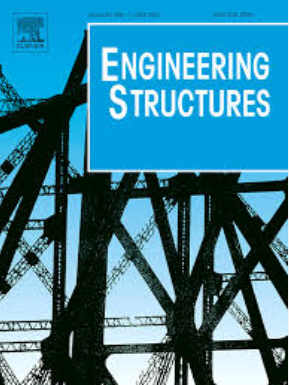Experimental and analytical investigation of long-term bond performance of basalt FRP-geopolymer concrete with varying alkalinities in marine environment
IF 5.6
1区 工程技术
Q1 ENGINEERING, CIVIL
引用次数: 0
Abstract
The degradation of basalt fiber reinforced polymer (BFRP) bars in alkaline environment affects their bond performance with concrete and limits their application as reinforcing materials. To address this issue, this study explores the use of geopolymer concrete as a replacement for traditional concrete, examining how the alkalinity of geopolymer affects the bond durability between BFRP bars and geopolymer concrete. The deterioration of bond performance and physicochemical properties were studied through pull-out tests and microscale characterization. After exposure at 55 °C for 135 days, the bond stress retention for specimens with a low pH level of 11.74 was 73 %. Reducing the alkalinity helps to minimize BFRP bar degradation by decreasing debonding at the fiber-resin interface and reducing fiber cracking. The revised chemical etching theory predicts the time required for the long-term bond strength retention of specimens with controlled alkalinity to decrease to 70 %. Additionally, a new bond-slip model is proposed to describe the bond-slip behavior between BFRP bars and geopolymer concrete. This study provides insight into using low-alkalinity geopolymer to mitigate the deterioration of bond performance between BFRP bars and concrete.
求助全文
约1分钟内获得全文
求助全文
来源期刊

Engineering Structures
工程技术-工程:土木
CiteScore
10.20
自引率
14.50%
发文量
1385
审稿时长
67 days
期刊介绍:
Engineering Structures provides a forum for a broad blend of scientific and technical papers to reflect the evolving needs of the structural engineering and structural mechanics communities. Particularly welcome are contributions dealing with applications of structural engineering and mechanics principles in all areas of technology. The journal aspires to a broad and integrated coverage of the effects of dynamic loadings and of the modelling techniques whereby the structural response to these loadings may be computed.
The scope of Engineering Structures encompasses, but is not restricted to, the following areas: infrastructure engineering; earthquake engineering; structure-fluid-soil interaction; wind engineering; fire engineering; blast engineering; structural reliability/stability; life assessment/integrity; structural health monitoring; multi-hazard engineering; structural dynamics; optimization; expert systems; experimental modelling; performance-based design; multiscale analysis; value engineering.
Topics of interest include: tall buildings; innovative structures; environmentally responsive structures; bridges; stadiums; commercial and public buildings; transmission towers; television and telecommunication masts; foldable structures; cooling towers; plates and shells; suspension structures; protective structures; smart structures; nuclear reactors; dams; pressure vessels; pipelines; tunnels.
Engineering Structures also publishes review articles, short communications and discussions, book reviews, and a diary on international events related to any aspect of structural engineering.
 求助内容:
求助内容: 应助结果提醒方式:
应助结果提醒方式:


